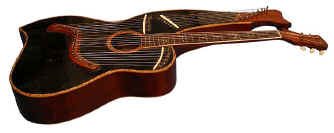
Once restored, set up and temporarily strung, I had to decide how best to tune and play this unusual guitar. I discovered (not unexpectedly) that the higher the short chord bank strings were tuned, the better they sounded. As with the fretless zither family, they also needed to be steel (bronze wound for a couple of the lower strings) and kept pretty tight to achieve any kind of tone. Fine on a box-type zither, scarier on a typical under-braced Knutsen! The top is virtually a trampoline (if you push on a treble string, the rest of the bank de-tunes like a "whammy bar"!) - believe me, the millisecond I finished recording, I relaxed the strings! When playing the guitar neck normally, the extra strings resonate quite a bit. When strummed in addition, the instrument sounds like a giant Autoharp. The two banks attached to the main bridge activate the thin top and produce a lot of sound from the main soundhole. The bank on the arm mainly causes just the arm to vibrate, with most of the sound coming out of the little soundhole - so it sounds much more "Oriental." As mentioned on the main page, the trebles sound best with no bridge - just coming right off the tuning pins. So I removed the bridges (my replacements sounded no better than the bone pieces) for recording (leaving a bone for the arm bank where the strings imbed directly into the top!).
I decided on a tuning of open D for the 6-string neck (D,A,d,f#,a,d'). For the chords, rather than string very heavy to very light (as the guitar was found) for a very spread out voicing, I chose a higher, tighter voicing. For the bank adjacent to the high neck string, I used a D chord, starting with the f# above the high d on the neck. With the 7 strings tuned f#',a',b',e'',f#'',a'',d''', one can strum from the low D string on the neck all the way across to the edge of the guitar, producing an open 13-note D6/9 chord (I would just sit there all evening, strumming that one glorious chord!). The bank opposite was tuned to the IV chord (G6: d', g', b', d'', e'', g'',b''), with the arm bank tuned to A7sus (V chord: g', a', d'', e'', g'', a'', d''').
For some inexplicable reason (and another reason I chose open D), I kept imagining that an arrangement of "Little Martha," the well known Allman Brothers tune from Eat a Peach would be ideal (I learned it in High School but hadn't played it since). It's a relatively simple piece with the three chords I had available (though I had to re-learn and re-tab it off the record all over again!). I'm still a multi-instrumentalist, with harps and lutes to play, so I'm stuck using guitar fingerpicks. (June, 2014: Interesting to read this: I've subsequently gone acrylics, and thus do not play the harps and lutes at the moment).
As an experiment, I recorded this dry - no reverb, EQ, chorus effects, nothing. Only a vintage Neumann SM69 stereo mic through a Demeter Tube mic pre-amp (first time I've used this set-up).
June, 2014: Recorded ten years ago, this piece will finally be officially released on my all-Knutsen CD project, coming if not soon, at least inevitably! (over half complete)
[Biographical]
[Instruments]
[Historical
Photos]
[Credits]
[FAQ]
[Bibliography]
[Updates]
[Links]
[Contact]
[Home
(Knutsen Archives)] [Home
(Harpguitars.net)]
All Site Contents Copyright © Gregg Miner, 2002, 2003, 2004, 2005,2006,2007,2008,2009,2010,2011,2012. All Rights Reserved.
Copyright and Fair Use of material and use of images: See Copyright and Fair Use policy.